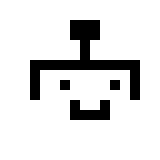 |
ASIMO |
|---|
| 2000 | 2001 | 2002 | 2003 | 2004 | 2005 | 2007 | 2011 |
|---|
2007 (Version 2.5)

On December 11th, 2007, an enhancement to ASIMO 2005 was announced, focusing on collaboration between ASIMOs. During the announcement, Honda told the media that they planned on placing two ASIMO units in the lobby of their Aoyama, Tokyo headquarters to perform customer service tasks, starting the next day, December 12th.[1]
Software
The back bone of this revision is collaboration. And to facilitate this, multiple ASIMO units can be connected to eachother via a network server. Depending where an ASIMO is and where a job needs to be performed, a time optimized schedule is created and different tasks are delegated to different ASIMO units.
If ASIMO predicts a person's walking path to intersect it's own, it will move out of the person's path and pass by walking around them. This is also possible in the case where the walking path of two ASIMOs would interect. If there isn't enough space to pass, ASIMO will step back and give the right of way to the person.
Ancillary Equipent


ASIMO could now automatically locate and dock to a charger when its batteries were low. Since all ASIMOs are connected over the network, if one is in the middle of a task and gets low on charge, another one can assume the role of the other and complete the task, ensuring continuous service without interruption.
It uses markers on the ground to align itself with the charger withing a few millimeters. The guide pin on the connector is tapered as well, so small errors can be tolerated.[2]


Touch screen terminal located at the end of each table for ordering drinks.


The tray and table marker used for drink delivery.
Research
EEG/NIRS simultaneous measurement device (BMI)

Announced March 31, 2009, Honda Research Institute Japan Co., Ltd. (HRI-JP), along with Advanced Telecommunications Research Institute International (ATR) and Shimadzu Corporation had developed a new Brain Machine Interface called the "EEG/NIRS simultaneous measurement device".[5] This 300kg machine hosts the ability to read the brain activity of a user, and translates that into actions on the ASIMO robot. A user has to wear a sensor cap fitted with electrodes, which measure brain waves using EEG and NIRS sensors.

For the BMI to register actions, the user has to imagine themselves doing one of four things, moving either their left or right hand, walking, or moving their tongue. Each of these mental actions has a predetermined response for ASIMO to perform, and once one is detected by the BMI, the computer sends the command for ASIMO to start its sequence.

At the time of announcement, only 3 people had been registered with this BMI. I takes about 2 hours to record data used to learn the brain patterns of a new user. Once someone is registered, it takes anywhere from 7 to 9 seconds to detect the imagined movement.
Most BMIs use either EEG or NIRS. EEG has good temporal resolution, but not spacial. NIRS has good spacial resolution, but not temporal. This system combines both methods to achieve high temporal and spatial resolution, utilizing 64 EEG channels and 48 NIRS channels.[4] Previous solutions yielded success rates of 66%, this one boasts 90.6%.
Appearances
April 23, 2008 - ASIMO conducts the Detroit Symphony Orchestra
References
- Honda Develops Intelligence Technologies Enabling Multiple ASIMO Robots to Work Together in Coordination
- Experience ASIMO's Guidance and Delivery Service ~ ASIMO autonomously walks around in ordinary spaces
- ASIMO takes a step into the real world: Demonstration of cooperative movements by multiple units
- People think and ASIMO moves
- Honda, ATR and Shimadzu Jointly Develop Brain-Machine Interface Technology